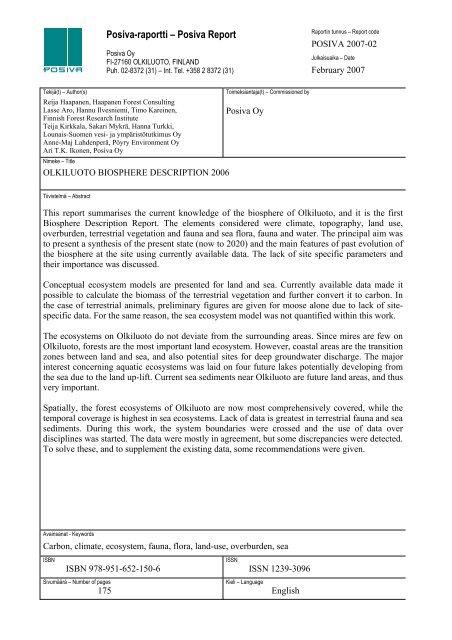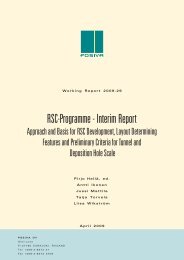Olkiluoto Biosphere Description 2006 (pdf) (4.1 MB) - Posiva
Olkiluoto Biosphere Description 2006 (pdf) (4.1 MB) - Posiva
Olkiluoto Biosphere Description 2006 (pdf) (4.1 MB) - Posiva
Create successful ePaper yourself
Turn your PDF publications into a flip-book with our unique Google optimized e-Paper software.
<strong>Posiva</strong>-raportti – <strong>Posiva</strong> Report<strong>Posiva</strong> OyFI-27160 OLKILUOTO, FINLANDPuh. 02-8372 (31) – Int. Tel. +358 2 8372 (31)Raportin tunnus – Report codePOSIVA 2007-02Julkaisuaika – DateFebruary 2007Tekijä(t) – Author(s)Reija Haapanen, Haapanen Forest ConsultingLasse Aro, Hannu Ilvesniemi, Timo Kareinen,Finnish Forest Research InstituteTeija Kirkkala, Sakari Mykrä, Hanna Turkki,Lounais-Suomen vesi- ja ympäristötutkimus OyAnne-Maj Lahdenperä, Pöyry Environment OyAri T.K. Ikonen, <strong>Posiva</strong> OyNimeke – TitleOLKILUOTO BIOSPHERE DESCRIPTION <strong>2006</strong>Toimeksiantaja(t) – Commissioned by<strong>Posiva</strong> OyTiivistelmä – AbstractThis report summarises the current knowledge of the biosphere of <strong>Olkiluoto</strong>, and it is the first<strong>Biosphere</strong> <strong>Description</strong> Report. The elements considered were climate, topography, land use,overburden, terrestrial vegetation and fauna and sea flora, fauna and water. The principal aim wasto present a synthesis of the present state (now to 2020) and the main features of past evolution ofthe biosphere at the site using currently available data. The lack of site specific parameters andtheir importance was discussed.Conceptual ecosystem models are presented for land and sea. Currently available data made itpossible to calculate the biomass of the terrestrial vegetation and further convert it to carbon. Inthe case of terrestrial animals, preliminary figures are given for moose alone due to lack of sitespecificdata. For the same reason, the sea ecosystem model was not quantified within this work.The ecosystems on <strong>Olkiluoto</strong> do not deviate from the surrounding areas. Since mires are few on<strong>Olkiluoto</strong>, forests are the most important land ecosystem. However, coastal areas are the transitionzones between land and sea, and also potential sites for deep groundwater discharge. The majorinterest concerning aquatic ecosystems was laid on four future lakes potentially developing fromthe sea due to the land up-lift. Current sea sediments near <strong>Olkiluoto</strong> are future land areas, and thusvery important.Spatially, the forest ecosystems of <strong>Olkiluoto</strong> are now most comprehensively covered, while thetemporal coverage is highest in sea ecosystems. Lack of data is greatest in terrestrial fauna and seasediments. During this work, the system boundaries were crossed and the use of data overdisciplines was started. The data were mostly in agreement, but some discrepancies were detected.To solve these, and to supplement the existing data, some recommendations were given.Avainsanat - KeywordsCarbon, climate, ecosystem, fauna, flora, land-use, overburden, seaISBNISBN 978-951-652-150-6ISSNISSN 1239-3096Sivumäärä – Number of pages175Kieli – LanguageEnglish
















